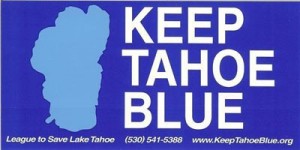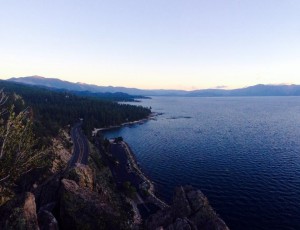
Written by Meredith Murray (Master’s in Environmental Policy Candidate 2015)
Driving into the Lake Tahoe Basin you are surrounded by sapphire blue water varying in colors and parts of the Sierra Nevada mountain range. It is no wonder why they call the lake “the Jewel of the Sierras”. Lake Tahoe is a unique piece to the Sierra Nevada landscape because it is the second deepest lake in the United States and borders between two states, Nevada and California.
What brought me to “the Jewel of the Sierras” is my internship with the League to Save Lake Tahoe (the League). To be honest I did not know much about Lake Tahoe until one of fellow colleagues at Bard Center for Environmental Policy (CEP) mentioned an internship opening with the League analyzing area plans surrounding the Tahoe Basin. After doing some research on the organization, I decided to initiate in the possibility of working with them for the Summer and Fall months. What sprung my interest in working with the League is their mission to protect and preserve the environmental health, sustainability and scenic beauty of the Lake Tahoe Basin.

The League is a private non-profit 501(c)(3) environmental advocacy organization existing in South Lake Tahoe, California since 1957. The organization hosts an array of projects to help keep Tahoe’s waters crystal clear, maintain the abundance of native species and increase the local knowledge about the Basin. With thousands of active members and volunteers the League’s programs include Eyes on the Lake, where volunteers report any invasive non-native species spotted in the Lake’s waters, and Pipe Keepers, where volunteers assist in monitoring pollution levels in water coming out of storm drains surrounding the Tahoe Basin. In addition, the League works with various jurisdictions and stakeholders to instill environmental standards within the surrounding communities.
My role in all of this is working with the League’s policy analyst in analyzing area plans to ensure that they comply with the Tahoe Regional Planning Agency’s (TRPA) 2012 new Regional Plan for the Tahoe Basin. Area plans are documents containing land use, conservation, transportation, recreation, and implementation goals and policies for a specific county. After a few months working with the League on interpreting several area plans, I realized the controversy that arises from these documents. Community members, TRPA, the League and the local jurisdictions all play active roles in the modification and implementation of Tahoe area plans. If not all of the stakeholders are on the same page, implementation of an area plan may get delayed for months or even years.
Working at the League varies on a daily basis with the tasks that I am assigned to do. Most time is spent reading area plans and assisting in comment letter preparation. Some weeks I go to community meetings regarding the proposed area plans. The community meetings allow for citizens to have a say in whether or not they agree with what the proposed plan wants to implement. In addition, the bi-state ownership of the Lake makes it all the more challenging to preserve the clarity of its waters. TRPA’s Governing Board are members from both California and Nevada and once a month I attend their meetings where they discuss policies and amendments to the 2012 Regional Plan, along with current Area Plans, Notice of Preparations (NOPs) and Environmental Impact Statements (EISs).
After working with the League for a few months I realized the political scrutiny that is surrounded with area plans. The League may not agree an area plan should be pushed forward if the community members are not on board. If the community members have a concern about a potential development, they will make sure their voices are heard. Just like any other political environment, it is all about negotiations and compromises. Not everyone can be happy but everyone can have say with how things should be done.
I never did much with area plans before interning with the League, but my coursework at Bard CEP provided me with stepping stones into how the whole process works. I am able to come into the internship with a working knowledge and the internship allows me to gain a hands on experience with the role of an environmental non-profit. I look forward to the next couple of months with reading EISs on a few of the area plans where I can put my environmental knowledge to some good use. I also plan on learning more from co-workers and their roles in preserving the Lake. Overall, Lake Tahoe is a beautiful area and one I have to come to deeply appreciate while living here.

